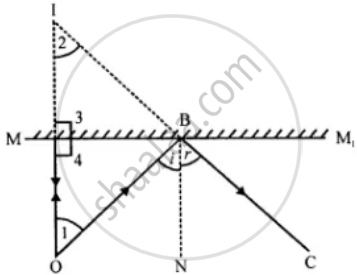Advertisements
Advertisements
प्रश्न
Prove experimentally that images are formed as far behind in a plane mirror as the object is in front of it.
उत्तर
Consider an object ‘O’ situated in front of a plane mirror MM, A ray of light which starts from point ‘O’ perpendicularly, is reflected back along the same path (See the following figure).
However, another ray that moves along OB is reflected along with BC, obeying the laws of reflection, such that BN is normal. Produce OA and CB backward, such that they meet at a point I. Then ‘I’ is the image of ‘O’.
We have to prove that OA = IA
∠i = ∠r [By the laws of reflection] ...(i)
Also, ∠i = ∠l [Pair of alternate angles] ...(ii)
∠r = ∠2 [Pair of corresponding angles]
Comparing (i) and (ii), ∴ ∠l = ∠2

In ΔBAI and BAO
∠1 = ∠2 [Proved]
∠3 = ∠4 [Each = 90°]
BA = BA [Common to both Δs]
∴ ΔBAI ≅ ΔBAO
Thus, in particular OA = IA.
APPEARS IN
संबंधित प्रश्न
The diagram in Fig. shows an incident ray AO and the reflected ray OB from a plane mirror. The angle AOB is 30°. Draw normal on the plane mirror at the point O and find:
An insect is sitting in front of a plane mirror at a distance 1 m from it.
(b) What is the distance between the insect and its image?
In the barber's shop, two plane mirrors are placed :
State the mirror formula for the formation of total number of images formed in two plane mirrors, held at an angle.
Calculate the number of images formed in two plane mirrors, when they are held at the angle of (i) 72° (ii) 36°.
What should be the minimum size of a plane mirror, so that a person 182 cm high can see himself completely?
A boy stands 4 m away from the plane mirror. If the boy moves `1/2` m towards the mirror, what is now the distance between the boy and his image? Give a reason for your answer.
